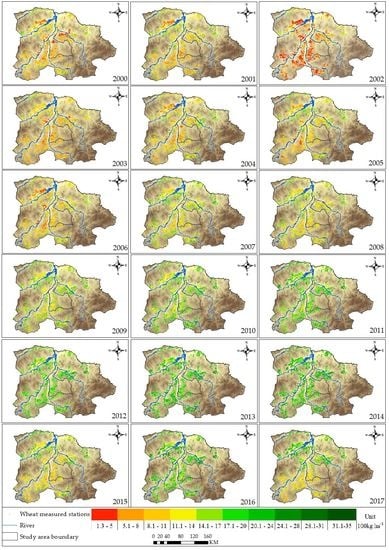Determination of Appropriate Remote Sensing Indices for Spring Wheat Yield Estimation in Mongolia
Abstract
:1. Introduction
2. Study Area and Data
2.1. Study Area
2.2. MODIS Data and Processing
2.3. Crop Data
3. Methodologies
3.1. Calculation of Remote Sensing Nine Indices:
3.2. Sensitive Analysis between Remote Sensing Indicators and Crop Yield
3.3.1. Crop Yield Estimation Model
3.3.2. Model Performance Evaluation
4. Results
4.1. Temporal Climate Variables and Remote Sensing Indices Profiles for Spring Wheat
4.2. Sensitivity Analysis between Remote Sensing Indicators and Crop Yield
4.3. Yield Estimation Model
4.4. Evaluation of Spring Wheat Yield at the Regional Scale
5. Discussions
6. Conclusions
Author Contributions
Funding
Acknowledgments
Conflicts of Interest
References
- Rosegrant, M.W. Global Food Security: Challenges and Policies. Science 2003, 302, 1917–1919. [Google Scholar] [CrossRef] [Green Version]
- Becker-Reshef, I.; Vermote, E.; Lindeman, M.; Justice, C. A generalized regression-based model for forecasting winter wheat yields in Kansas and Ukraine using MODIS data. Remote Sens. Environ. 2010, 114, 1312–1323. [Google Scholar] [CrossRef]
- Batchuluun, A.; Lin, J.Y. An Analysis of Mining Sector Economics in Mongolia. Glob. J. Bus. Res. 2010, 4, 81–93. [Google Scholar]
- Coslet, C.; Palmeri, F.; Sukhbaatar, J.; Batjargal, E.; Wadhwa, A. Special Report FAO/WFP Crop and Livestock Assessment Mission to Mongolia. 2017. Available online: http://www.wfp.org/food-security/reports/ (accessed on 28 October 2017).
- Erdenee, B.; Tana, G.; Tateishi, R. Cropland information system in Mongolia using remote sensing and geographical information system: Case study in Tsagaannuur, Selenge aimag. Int. J. Geomat. Geosci. 2010, 1, 577–586. [Google Scholar]
- Altansukh, N. Mongolia: Country Report the FAO International Technical Conference on Plant Geneticresources. Available online: http://www.fao.org/fileadmin/templates/agphome/documents/PGR/SoW1/east/MONGOLIA.pdf (accessed on 28 October 2017).
- Bao, G.; Qin, Z.; Bao, Y.; Zhou, Y.; Li, W.; Sanjjav, A. NDVI-Based Long-Term Vegetation Dynamics and Its Response to Climatic Change in the Mongolian Plateau. Remote Sens. 2014, 6, 8337–8358. [Google Scholar] [CrossRef] [Green Version]
- Gantsetseg, B.; Ishizuka, M.; Kurosaki, Y.; Mikami, M. Topographical and hydrological effects on meso-scale vegetation in desert steppe, Mongolia. J. Arid Land 2017, 9, 132–142. [Google Scholar] [CrossRef]
- Batima, P.; Natsagdorj, L.; Gombluudev, P.; Erdenetsetseg, B. Observed climate change in Mongolia. AIACC Work. Pap. 2005, 12, 1–25. [Google Scholar]
- Nanzad, L.; Zhang, J.; Tuvdendorj, B.; Nabil, M.; Zhang, S.; Bai, Y. NDVI anomaly for drought monitoring and its correlation with climate factors over Mongolia from 2000 to 2016. J. Arid Environ. 2019, 164, 69–77. [Google Scholar] [CrossRef]
- Sui, J.; Qin, Q.; Ren, H.; Sun, Y.; Zhang, T.; Wang, J.; Gong, S. Winter wheat production estimation based on environmental stress factors from satellite observations. Remote Sens. 2018, 10, 962. [Google Scholar] [CrossRef]
- Petersen, L.K. Real-time prediction of crop yields from MODIS relative vegetation health: A continent-wide analysis of Africa. Remote Sens. 2018, 10, 1726. [Google Scholar] [CrossRef]
- Atzberger, C. Advances in Remote Sensing of Agriculture: Context Description, Existing Operational Monitoring Systems and Major Information Needs. Remote Sens. 2013, 5, 949–981. [Google Scholar] [CrossRef] [Green Version]
- Dong, T.; Shang, J.; Qian, B.; Liu, J.; Chen, J.M.; Jing, Q.; McConkey, B.; Huffman, T.; Daneshfar, B.; Champagne, C.; et al. Field-Scale Crop Seeding Date Estimation from MODIS Data and Growing Degree Days in Manitoba, Canada. Remote Sens. 2019, 11, 1760. [Google Scholar] [CrossRef]
- He, T.; Xie, C.; Liu, Q.; Guan, S.; Liu, G. Evaluation and Comparison of Random Forest and A-LSTM Networks for Large-scale Winter Wheat Identification. Remote Sens. 2019, 11, 1665. [Google Scholar] [CrossRef]
- Kogan, F. World droughts in the new millennium from AVHRR-based vegetation health indices. Eos 2002, 83, 557. [Google Scholar] [CrossRef]
- Kogan, F.N. Operational space technology for global vegetation assessment. Bull. Am. Meteorol. Soc. 2001, 82, 1949–1964. [Google Scholar] [CrossRef]
- Ren, J.; Chen, Z.; Zhou, Q.; Tang, H. Regional yield estimation for winter wheat with MODIS-NDVI data in Shandong, China. Int. J. Appl. Earth Obs. Geoinf. 2008, 10, 403–413. [Google Scholar] [CrossRef]
- Sakamoto, T.; Gitelson, A.A.; Arkebauer, T.J. Near real-time prediction of U.S. corn yields based on time-series MODIS data. Remote Sens. Environ. 2014, 147, 219–231. [Google Scholar] [CrossRef]
- Singh, R.P.; Roy, S.; Kogan, F. Vegetation and temperature condition indices from NOAA AVHRR data for drought monitoring over India. Int. J. Remote Sens. 2003, 24, 4393–4402. [Google Scholar] [CrossRef]
- Yeom, J.; Jung, J.; Chang, A.; Ashapure, A.; Maeda, M.; Maeda, A.; Landivar, J. Comparison of Vegetation Indices Derived from UAV Data for Differentiation of Tillage Effects in Agriculture. Remote Sens. 2019, 11, 1548. [Google Scholar] [CrossRef]
- Guindin-Garcia, N.; Gitelson, A.A.; Arkebauer, T.J.; Shanahan, J.; Weiss, A. An evaluation of MODIS 8- and 16-day composite products for monitoring maize green leaf area index. Agric. For. Meteorol. 2012, 161, 15–25. [Google Scholar] [CrossRef] [Green Version]
- Rembold, F.; Atzberger, C.; Savin, I.; Rojas, O. Using Low-Resolution Satellite Imagery for Yield Prediction and Yield Anomaly Detection. Remote Sens. 2013, 5, 1704–1733. [Google Scholar] [CrossRef]
- Malingreau, J.P. Global vegetation dynamics: Satellite observations over Asia. Int. J. Remote Sens. 1986, 7, 1121–1146. [Google Scholar] [CrossRef]
- Tucker, C.J.; Vanpraet, C.L.; Sharman, M.J.; Van Ittersum, G. Satellite remote sensing of total herbaceous biomass production in the senegalese sahel: 1980–1984. Remote Sens. Environ. 1985, 17, 233–249. [Google Scholar] [CrossRef]
- Battude, M.; Al Bitar, A.; Morin, D.; Cros, J.; Huc, M.; Sicre, C.M.; Le Dantec, V.; Demarez, V. Estimating maize biomass and yield over large areas using high spatial and temporal resolution Sentinel-2 like remote sensing data. Remote Sens. Environ. 2016, 184, 668–681. [Google Scholar] [CrossRef]
- Lopresti, M.F.; Di Bella, C.M.; Degioanni, A.J. Relationship between MODIS-NDVI data and wheat yield: A case study in Northern Buenos Aires province, Argentina. Inf. Process. Agric. 2015, 2, 73–84. [Google Scholar] [CrossRef] [Green Version]
- Sandford, S.A.; Bernstein, M.P.; Materese, C.K. NASA Public Access. Astrophys. J. Suppl. Ser. 2013, 205, 1–58. [Google Scholar]
- Lewis, J.E.; Rowland, J.; Nadeau, A. Estimating maize production in kenya using ndvi: Some statistical considerations. Int. J. Remote Sens. 1998, 19, 2609–2617. [Google Scholar] [CrossRef]
- Vicente-Serrano, S.; Cuadrat-Prats, J.M.; Romo, A. Early prediction of crop production using drought indices at different time-scales and remote sensing data: Application in the Ebro Valley (north-east Spain). Int. J. Remote Sens. 2006, 27, 511–518. [Google Scholar] [CrossRef]
- Carlson, T.N.; Gillies, R.R.; Perry, E.M. A method to make use of thermal infrared temperature and NDVI measurements to infer surface soil water content and fractional vegetation cover. Remote Sens. Rev. 1994, 9, 161–173. [Google Scholar] [CrossRef]
- Carlson, T.N.; Perry, E.M.; Schmugge, T.J. Remote estimation of soil moisture availability and fractional vegetation cover for agricultural fields. Agric. For. Meteorol. 1990, 52, 45–69. [Google Scholar] [CrossRef]
- Zhang, N.; Hong, Y.; Qin, Q.; Zhu, L. Evaluation of the Visible and Shortwave Infrared Drought Index in China. Int. J. Disaster Risk Sci. 2013, 4, 68–76. [Google Scholar] [CrossRef]
- Wang, L.; Qu, J.J. NMDI: A normalized multi-band drought index for monitoring soil and vegetation moisture with satellite remote sensing. Geophys. Res. Lett. 2007, 34. [Google Scholar] [CrossRef]
- Huang, J.; Ma, H.; Sedano, F.; Lewis, P.; Liang, S.; Wu, Q.; Su, W.; Zhang, X.; Zhu, D. Evaluation of regional estimates of winter wheat yield by assimilating three remotely sensed reflectance datasets into the coupled WOFOST–PROSAIL model. Eur. J. Agron. 2019, 102, 1–13. [Google Scholar] [CrossRef]
- Jones, J.W.; Hoogenboom, G.; Porter, C.H.; Boote, K.J.; Batchelor, W.D.; Hunt, L.A.; Wilkens, P.W.; Singh, U.; Gijsman, A.J.; Ritchie, J.T. The DSSAT cropping system model. Eur. J. Agron. 2003, 18, 235–265. [Google Scholar] [CrossRef]
- Rezzoug, W.; Gabrielle, B.; Suleiman, A.; Benabdeli, K. Application and evaluation of the DSSAT-wheat in the Tiaret region of Algeria. African J. Agric. Res. 2008, 3, 284–296. [Google Scholar]
- Zhuo, W.; Huang, J.; Li, L.; Huang, R.; Gao, X.; Zhang, X.; Zhu, D. Assimilating SAR and Optical Remote Sensing Data into WOFOST Model for Improving Winter Wheat Yield Estimation. In Proceedings of the 2018 7th International Conference on Agro-geoinformatics (Agro-geoinformatics), Hangzhou, China, 6–9 August 2018; pp. 1–5. [Google Scholar]
- Ceglar, A.; van der Wijngaart, R.; de Wit, A.; Lecerf, R.; Boogaard, H.; Seguini, L.; van den Berg, M.; Toreti, A.; Zampieri, M.; Fumagalli, D.; et al. Improving WOFOST model to simulate winter wheat phenology in Europe: Evaluation and effects on yield. Agric. Syst. 2019, 168, 168–180. [Google Scholar] [CrossRef]
- Gilardelli, C.; Stella, T.; Frasso, N.; Cappelli, G.; Bregaglio, S.; Chiodini, M.E.; Scaglia, B.; Confalonieri, R. WOFOST-GTC: A new model for the simulation of winter rapeseed production and oil quality. Field Crop. Res. 2016, 197, 125–132. [Google Scholar] [CrossRef]
- Otgonbayar, M.; Atzberger, C.; Chambers, J.; Amarsaikhan, D.; Böck, S.; Tsogtbayar, J. Land Suitability Evaluation for Agricultural Cropland in Mongolia Using the Spatial MCDM Method and AHP Based GIS. J. Geosci. Environ. Prot. 2017, 5, 238–263. [Google Scholar] [CrossRef] [Green Version]
- Natsagdorj, E.; Renchin, T.; De Maeyer, P.; Dari, C.; Tseveen, B. Long-term soil moisture content estimation using satellite and climate data in agricultural area of Mongolia. Geocarto Int. 2019, 34, 722–734. [Google Scholar] [CrossRef]
- Ariya, B. Land Degradation Assessment in an Agricultural Area of Mongolia: Case Study in Orkhon Soum. United Nations University Land Restoration Training Programme [final project]. 2017, pp. 1–20. Available online: http://www.unulrt.is/static/fellows/document/ariya2017.pdf (accessed on 28 October 2017).
- Chang, S.; Wu, B.; Yan, N.; Davdai, B.; Nasanbat, E. Suitability assessment of satellite-derived drought indices for Mongolian grassland. Remote Sens. 2017, 9, 650. [Google Scholar] [CrossRef]
- Tsegmid, S.; Vorobiev, V. The National Atlas; Mongolian People’s Republic (in Mongolian). GUGK SSSR GUGK MNR Mosc: Ulaanbaatar, Mongolia, 1990. [Google Scholar]
- Kastens, J.; Kastens, T.; Kastens, D.; Price, K.; Martinko, E.; Lee, R. Image masking for crop yield forecasting using AVHRR NDVI time-series imagery. Remote Sens. Environ. 2005, 99, 341–356. [Google Scholar] [CrossRef]
- Elbegjargal, N.; Khudulmur, S.; Tsogtbaatar, J.; Dash, D.; Mandakh, N. Desertification Atlas of Mongolia; Institute of Geoecology, Mongolian Academy of Sciences: Ulaanbaatar, Mongolia, 2014. [Google Scholar]
- Mkhabela, M.S.; Bullock, P.; Raj, S.; Wang, S.; Yang, Y. Crop yield forecasting on the Canadian Prairies using MODIS NDVI data. Agric. For. Meteorol. 2011, 151, 385–393. [Google Scholar] [CrossRef]
- Dempewolf, J.; Adusei, B.; Becker-Reshef, I.; Hansen, M.; Potapov, P.; Khan, A.; Barker, B. Wheat yield forecasting for Punjab Province from vegetation index time series and historic crop statistics. Remote Sens. 2014, 6, 9653–9675. [Google Scholar] [CrossRef]
- Kogan, F.; Gitelson, A.; Zakarin, E.; Spivak, L.; Lebed, L. AVHRR-based spectral vegetation index for quantitative assessment of vegetation state and productivity: Calibration and validation. Photogramm. Eng. Remote Sens. 2003, 69, 899–906. [Google Scholar] [CrossRef]
- Kogan, F.N. Droughts of the late 1980s in the United States as derived from NOAA polar-orbiting satellite data. Bull. Am. Meteorol. Soc. 1995, 76, 655–668. [Google Scholar] [CrossRef]
- Unganai, L.S.; Kogan, F.N. Drought monitoring and corn yield estimation in southern Africa from AVHRR data. Remote Sens. Environ. 1998, 63, 219–232. [Google Scholar] [CrossRef]
- Gitelson, A.A.; Kaufman, Y.J.; Merzlyak, M.N. Use of a green channel in remote sensing of global vegetation from EOS-MODIS. Remote Sens. Environ. 1996, 58, 289–298. [Google Scholar] [CrossRef]
- Holben, B.N. Characteristics of maximum-value composite images from temporal AVHRR data. Int. J. Remote Sens. 1986, 7, 1417–1434. [Google Scholar] [CrossRef]
- Tucker, C.J. Red and photographic infrared linear combinations for monitoring vegetation. Remote Sens. Environ. 1979, 8, 127–150. [Google Scholar] [CrossRef] [Green Version]
- Gao, B.C. NDWI—A normalized difference water index for remote sensing of vegetation liquid water from space. Remote Sens. Environ. 1996, 58, 257–266. [Google Scholar] [CrossRef]
- Kogan, F.N. Application of vegetation index and brightness temperature for drought detection. Adv. Space Res. 1995, 15, 91–100. [Google Scholar] [CrossRef]
- Jianbo, W.; Jianjun, B.; Lele, L.; Yuan, Y. Vegetation supply water index based on MODIS data Analysis of the in Yunnan in spring of 2012. In Proceedings of the Third International Conference on Agro-Geoinformatics, Beijing, China, 11–14 August 2014; pp. 1–7. [Google Scholar]
- Gu, Y.; Brown, J.F.; Verdin, J.P.; Wardlow, B. A five-year analysis of MODIS NDVI and NDWI for grassland drought assessment over the central Great Plains of the United States. Geophys. Res. Lett. 2007, 34, 06407. [Google Scholar] [CrossRef]
- Balaghi, R.; Tychon, B.; Eerens, H.; Jlibene, M. Empirical regression models using NDVI, rainfall and temperature data for the early prediction of wheat grain yields in Morocco. Int. J. Appl. Earth Obs. Geoinf. 2008, 10, 438–452. [Google Scholar] [CrossRef] [Green Version]
- Moriondo, M.; Maselli, F.; Bindi, M. A simple model of regional wheat yield based on NDVI data. Eur. J. Agron. 2007, 26, 266–274. [Google Scholar] [CrossRef]
- Bolton, D.K.; Friedl, M.A. Forecasting crop yield using remotely sensed vegetation indices and crop phenology metrics. Agric. For. Meteorol. 2013, 173, 74–84. [Google Scholar] [CrossRef]
- Nandintsetseg, B.; Shinoda, M. Seasonal change of soil moisture in Mongolia: Its climatology. Int. J. Clim. 2011, 31, 1143–1152. [Google Scholar] [CrossRef]
- Shinoda, M. Phenology of Mongolian Grasslands and Moisture Conditions. J. Meteorol. Soc. Jpn. 2007, 85, 359–367. [Google Scholar] [CrossRef] [Green Version]
- Delfine, S.; Loreto, F.; Alvino, A. Drought-stress Effects on Physiology, Growth and Biomass Production of Rainfed and Irrigated Bell Pepper Plants in the Mediterranean Region. J. Am. Soc. Hortic. Sci. 2001, 126, 297–304. [Google Scholar] [CrossRef]
- Azzaya, D. Agro-Meteorological Assessment of Plant Growth Conditions in the Central Region of Mongolia. Ph.D. Thesis, Mongolian University of Life Sciences, Ulaanbaatar, Mongolia, 1997. [Google Scholar]
- Loka, D. Effect of Water-Deficit Stress on Cotton During Reproductive Development. Ph.D. Thesis, University of Arkansas, Fayetteville, NC, USA, 2012. [Google Scholar]
- Liaqat, M.U.; Cheema, M.J.M.; Huang, W.; Mahmood, T.; Zaman, M.; Khan, M.M. Evaluation of MODIS and Landsat multiband vegetation indices used for wheat yield estimation in irrigated Indus Basin. Comput. Electron. Agric. 2017, 138, 39–47. [Google Scholar] [CrossRef]
- Royo, C.; Aparicio, N.; Villegas, D.; Casadesus, J.; Monneveux, P.; Araus, J.L. Usefulness of spectral reflectance indices as durum wheat yield predictors under contrasting Mediterranean conditions. Int. J. Remote Sens. 2003, 24, 4403–4419. [Google Scholar] [CrossRef]
- Dagvadorj, D.; Batjargal, Z.; Natsagdorj, L. Mongolia Second Assessment Report on Climate Change-2014; Ministry of Environment and Green Development of Mongolia with Financial Support from the GIZ Programme: Ulaanbaatar, Mongolia, 2014. [Google Scholar]
- Dorjsuren, M.; Liou, Y.A.; Cheng, C.H. Time-series MODIS and in situ data analysis for Mongolia drought. Remote Sens. 2016, 8, 509. [Google Scholar] [CrossRef]
- Alizadeh, V.; Shokri, V.; Soltani, A.; Yousefi, M.A. Effects of Climate Change and Drought-Stress on Plant Physiology. Int. J. Adv. Biol. Biomedical Res. 2014, 2, 468–472. [Google Scholar]
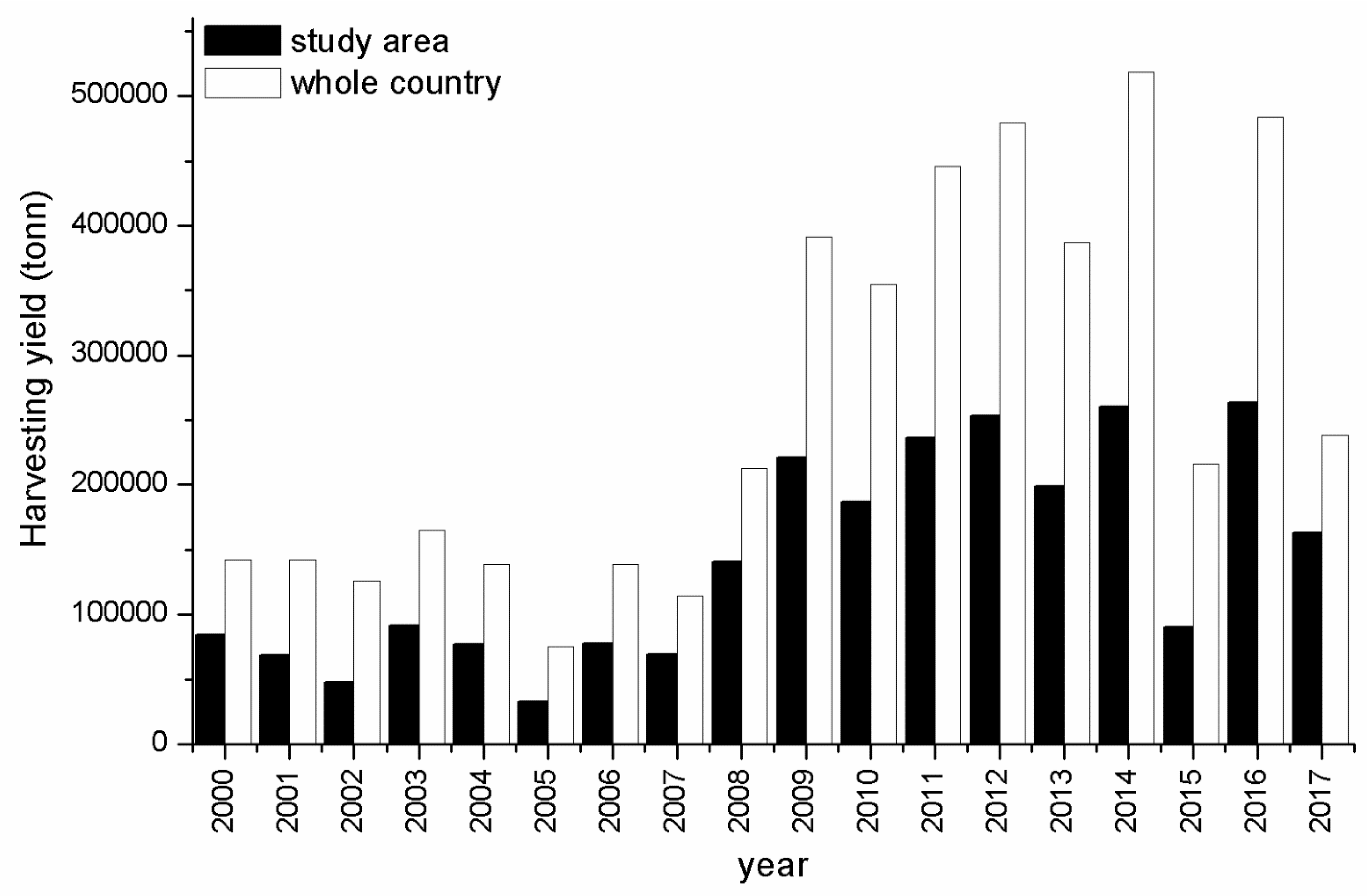
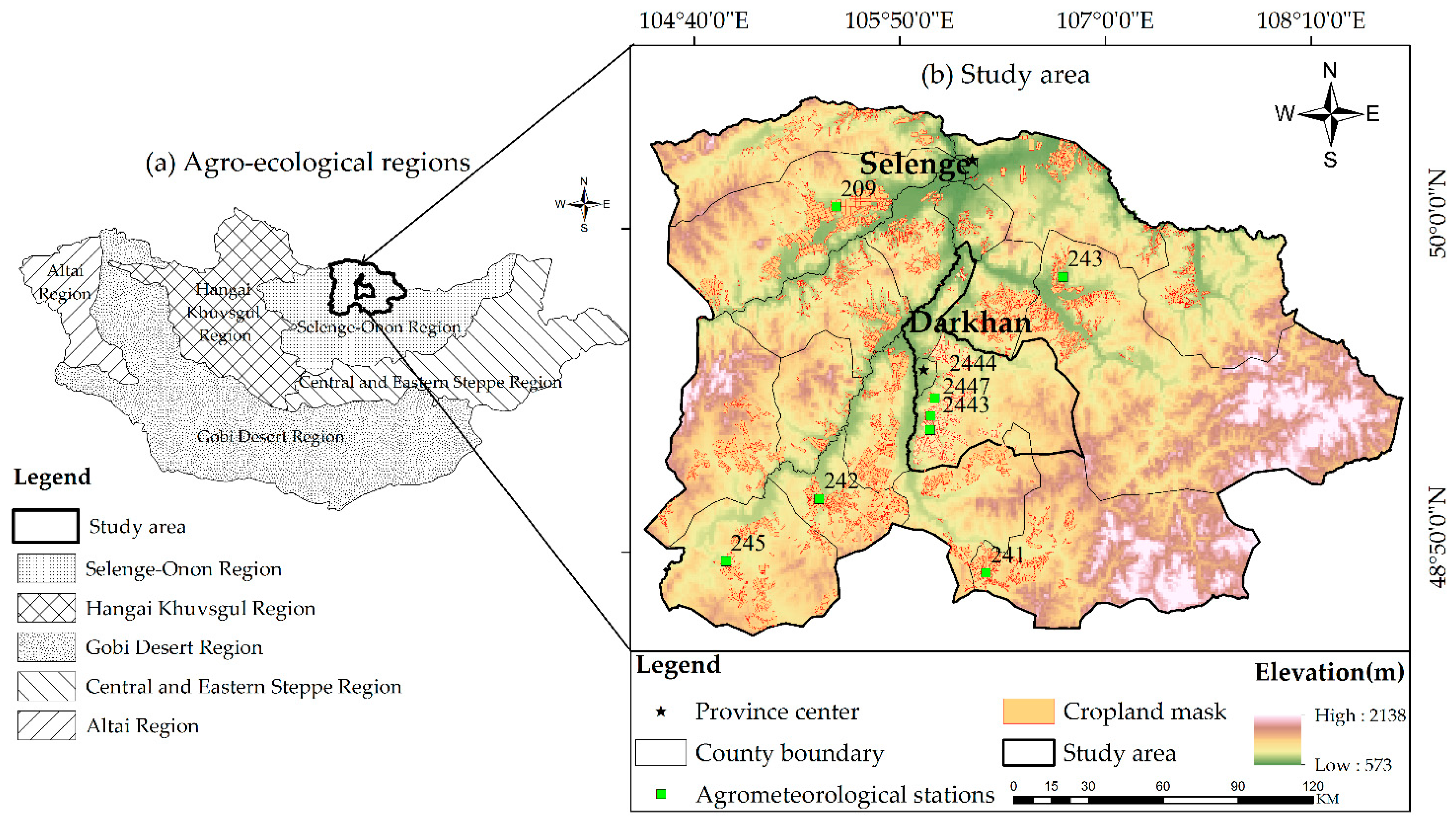

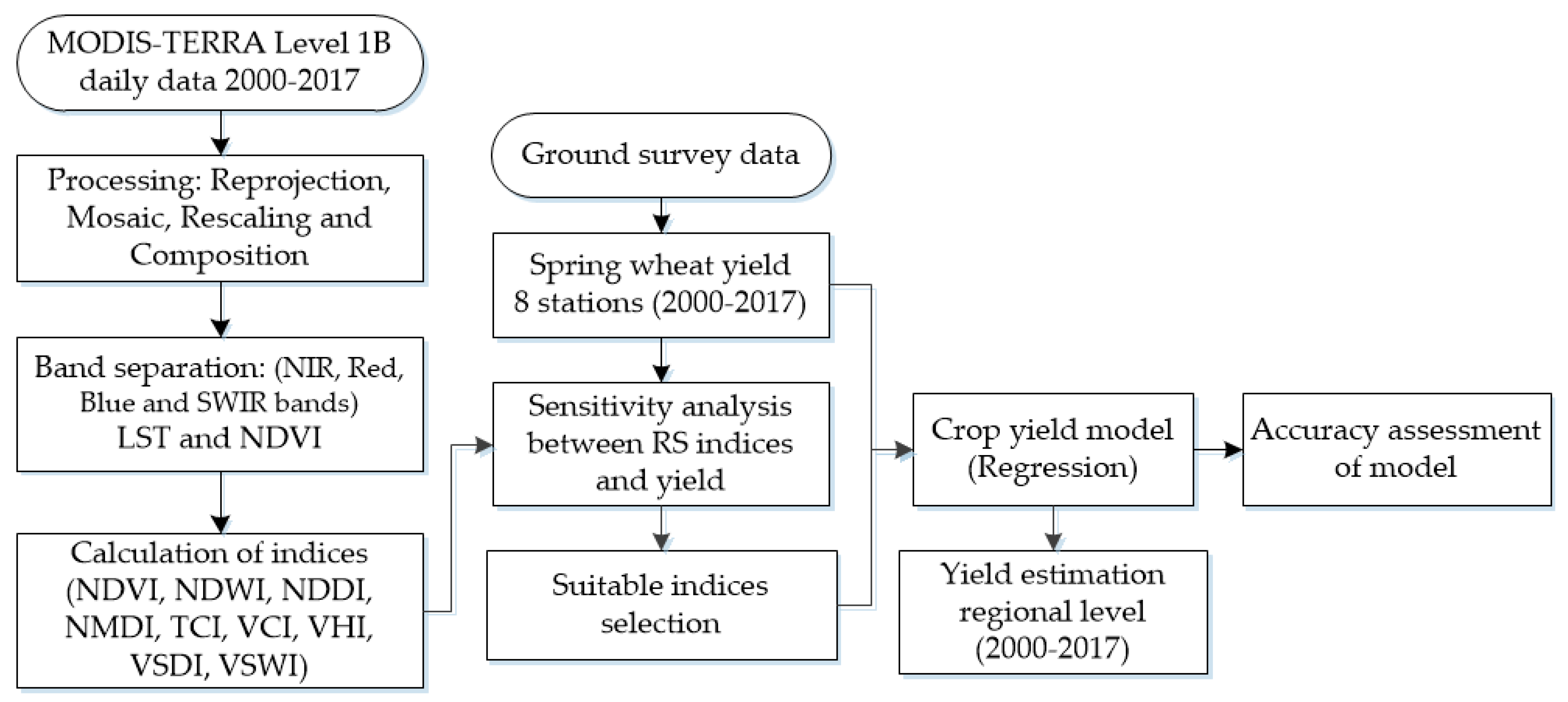
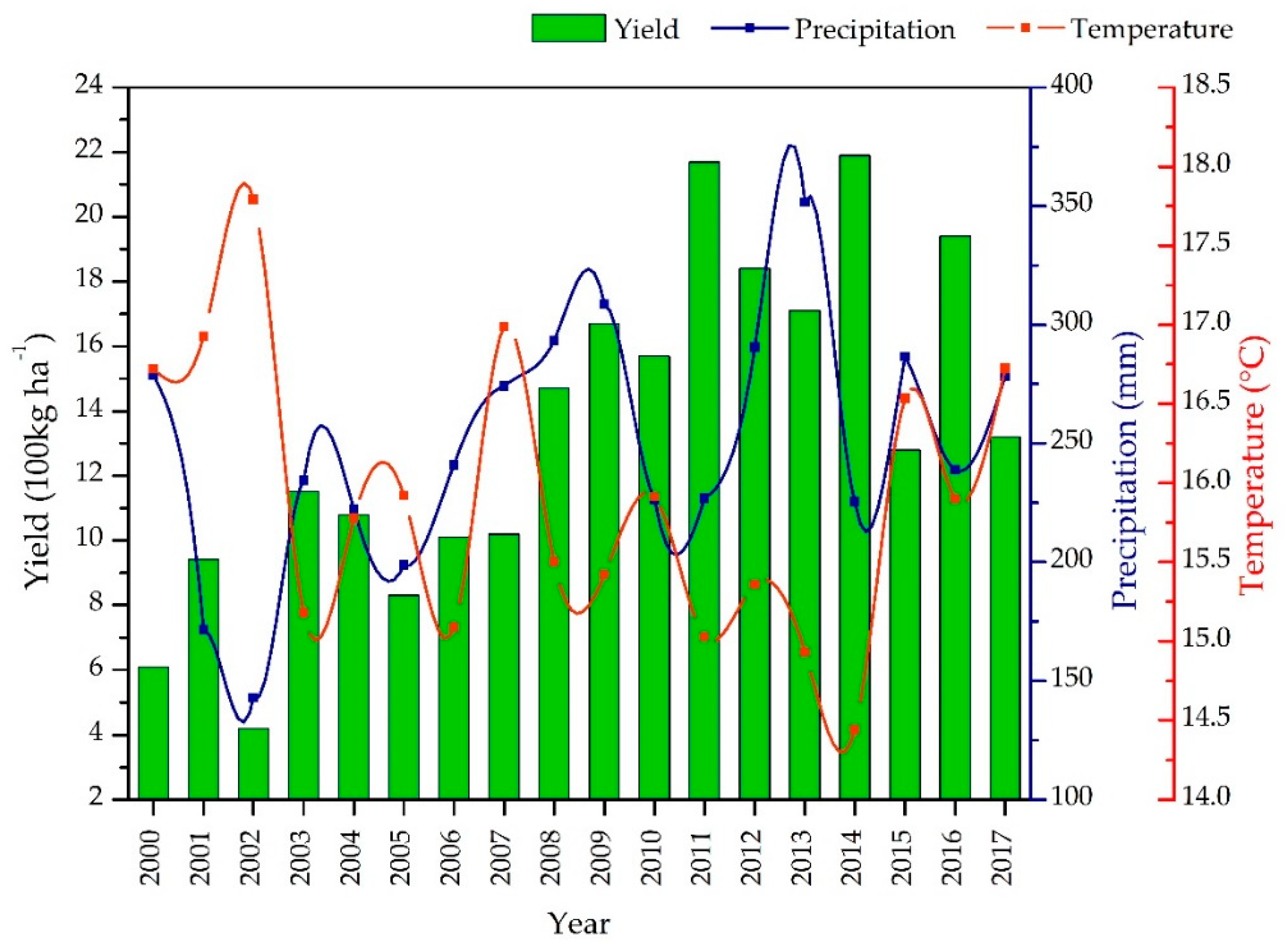
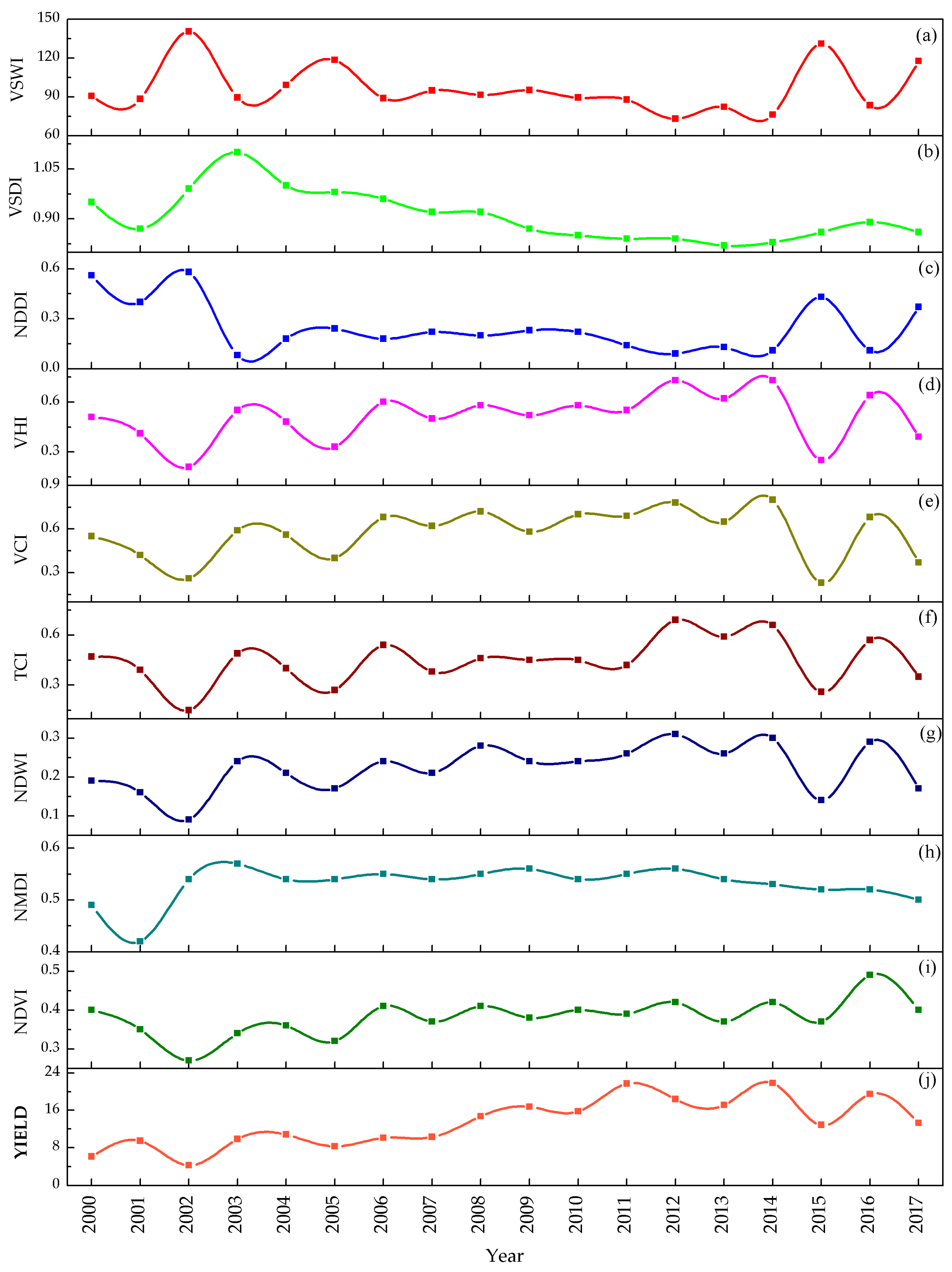
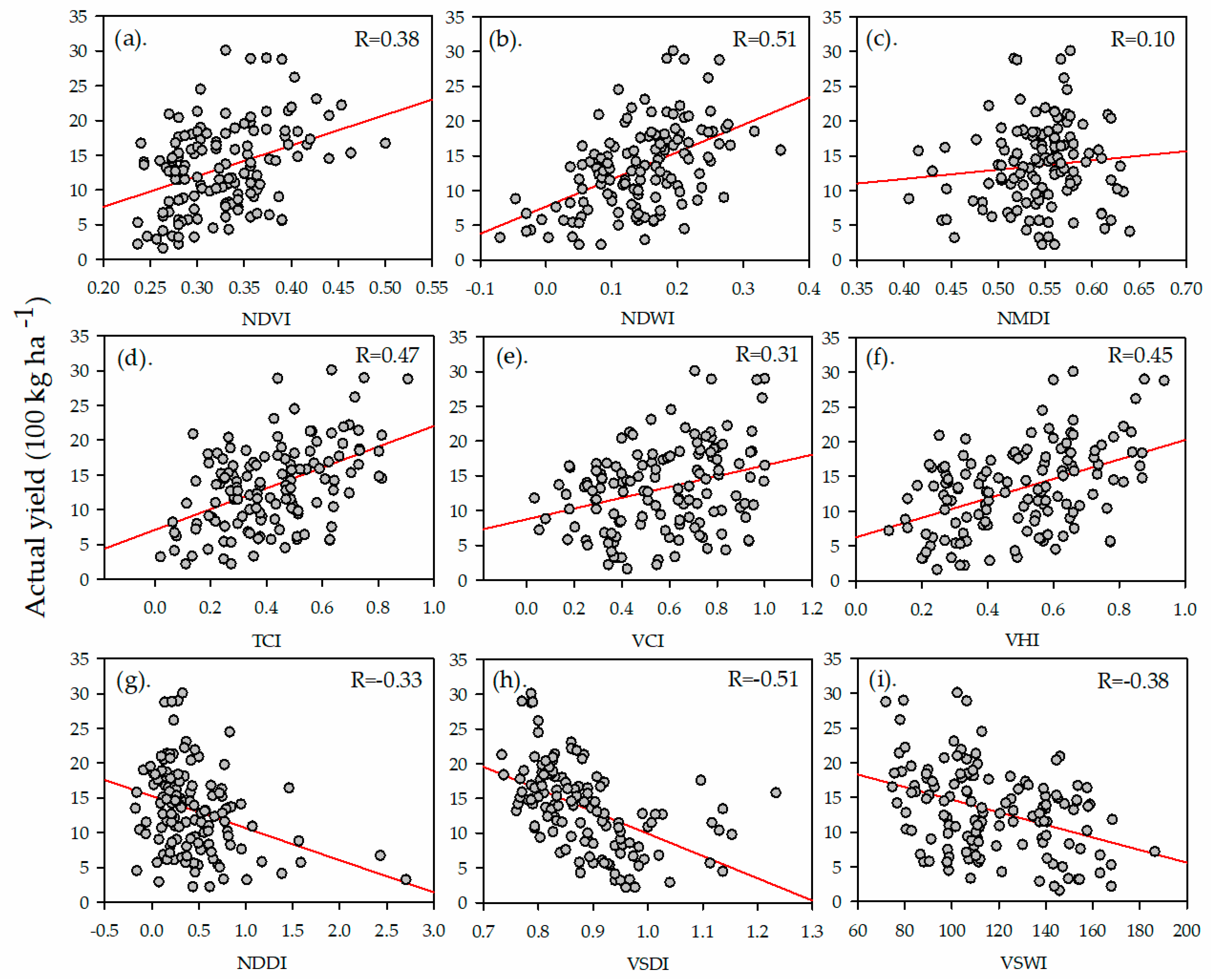
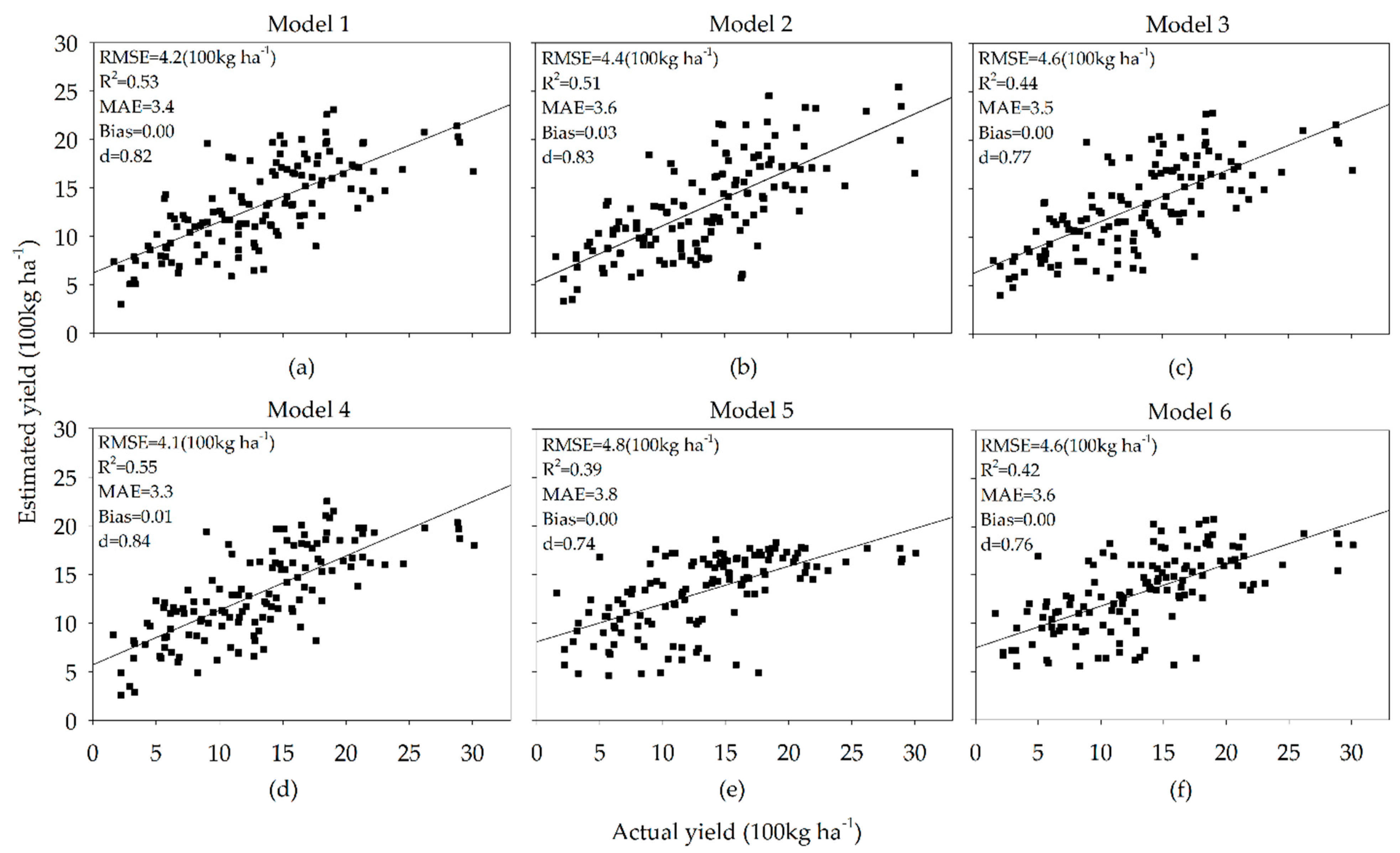
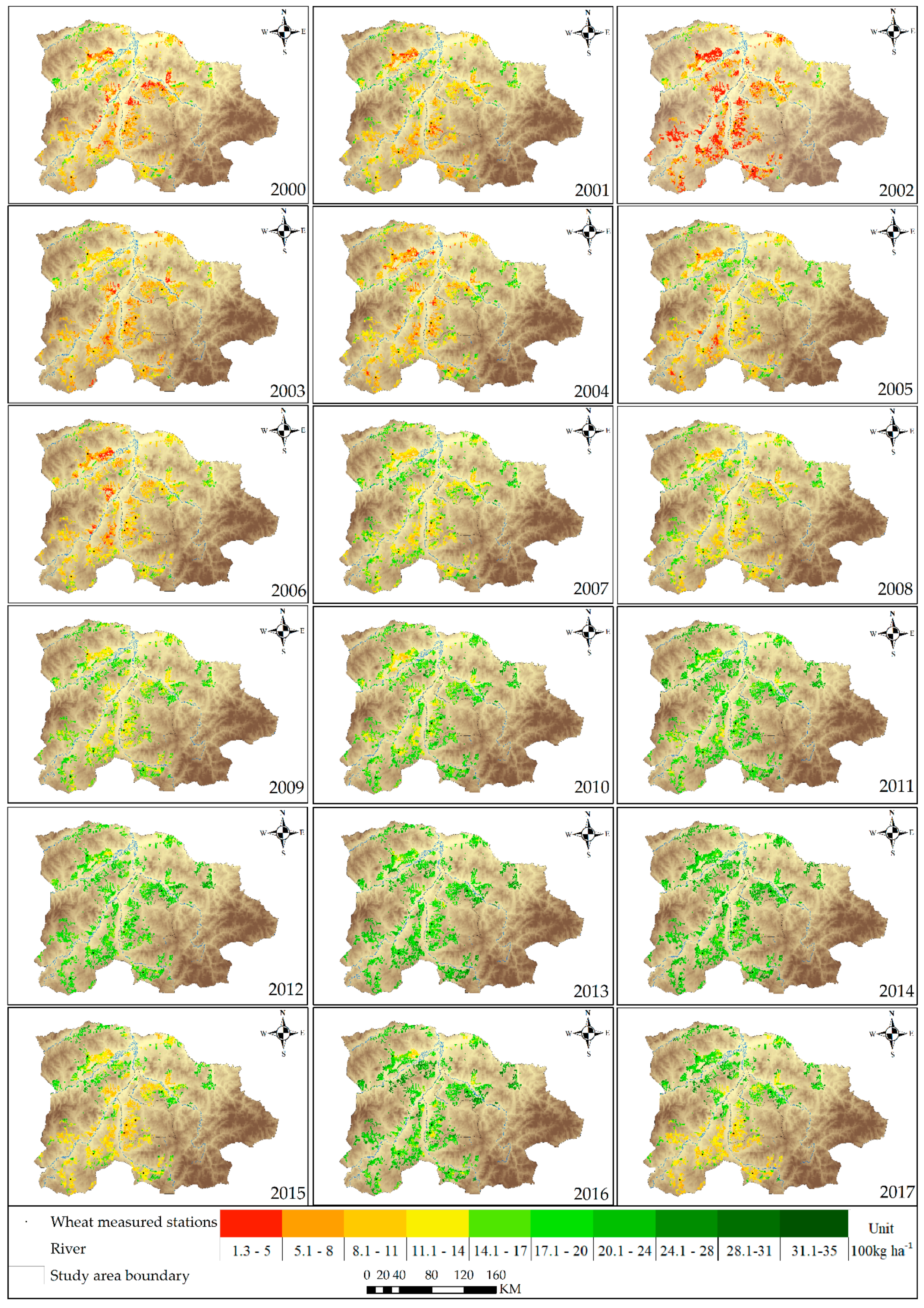
| N | Province Name | Station Name | Station ID | Latitude | Longitude | Crop Type |
|---|---|---|---|---|---|---|
| 1 | Selenge | Tsagaannuur | 209 | 50.0886 | 105.3252 | wheat |
| 2 | Selenge | Baruunkharaa | 241 | 48.7856 | 106.2624 | wheat |
| 3 | Selenge | Orkhon | 242 | 49.0039 | 105.4208 | wheat |
| 4 | Selenge | Eruu | 243 | 49.6842 | 106.6008 | wheat |
| 5 | Selenge | Orkhontuul | 245 | 48.7208 | 105.0358 | wheat |
| 6 | Darkhan | Tsaidam | 2443 | 49.3221 | 105.9826 | wheat |
| 7 | Darkhan | 6th Brigad | 2444 | 49.3602 | 106.0782 | wheat |
| 8 | Darkhan | Altangadas | 2447 | 49.2328 | 105.9466 | wheat |
| N | Remote Sensing Based Indices | Equation | References |
|---|---|---|---|
| 1 | Normalized Difference Vegetation Index | [55] | |
| 2 | Normalized Difference Water Index | [56] | |
| 3 | Vegetation Condition Index | [57] | |
| 4 | Temperature Condition Index | [57] | |
| 5 | Vegetation Health Index | [57] | |
| 6 | Normalized Multi-Band Drought Index | [34] | |
| 7 | Vegetation Supply Water Index | [58] | |
| 8 | Normalized Difference Drought Index | [59] | |
| 9 | Visible and Shortwave Infrared Drought Index | [33] |
| Month | Decade | Index | ||||||||
|---|---|---|---|---|---|---|---|---|---|---|
| NDVI | NMDI | NDWI | TCI | VCI | VHI | NDDI | VSDI | VSWI | ||
| June | First 10 days | 0.29 | 0.05 | 0.48 | 0.31 | 0.2 | 0.34 | −0.36 | −0.51 | −0.36 |
| Second 10 days | 0.32 | 0.13 | 0.4 | 0.24 | 0.16 | 0.32 | −0.23 | −0.44 | −0.31 | |
| Third 10 days | 0.31 | 0.02 | 0.46 | 0.57 | 0.06 | 0.46 | −0.27 | −0.52 | −0.22 | |
| July | First 10 days | 0.51 | 0.01 | 0.39 | 0.25 | 0.31 | 0.41 | −0.26 | −0.56 | −0.33 |
| Second 10 days | 0.3 | 0.18 | 0.39 | 0.24 | 0.24 | 0.32 | −0.38 | −0.52 | −0.3 | |
| Third 10 days | 0.27 | 0.1 | 0.34 | 0.18 | 0.27 | 0.21 | −0.35 | −0.54 | −0.21 | |
| August | First 10 days | 0.16 | 0.18 | 0.28 | 0.01 | 0.17 | 0.12 | −0.37 | −0.56 | −0.13 |
| Second 10 days | 0.31 | 0.17 | 0.27 | 0.08 | 0.25 | 0.35 | −0.14 | −0.14 | −0.22 | |
| Third 10 days | 0.3 | -0.07 | 0.42 | 0.26 | 0.28 | 0.35 | −0.33 | −0.11 | −0.35 | |
| N | Index | ||||||||
|---|---|---|---|---|---|---|---|---|---|
| NDVI | NMDI | NDWI | TCI | VCI | VHI | NDDI | VSDI | VSWI | |
| June | 0.38*** | 0.1 | 0.51*** | 0.47*** | 0.31*** | 0.45*** | −0.33*** | -0.51*** | −0.38*** |
| July | 0.47*** | 0.12 | 0.4*** | 0.29*** | 0.35*** | 0.35*** | −0.39*** | -0.57*** | −0.3*** |
| August | 0.28*** | 0.15 | 0.35*** | 0.17* | 0.38*** | 0.32*** | −0.37*** | -0.33*** | −0.25** |
| Month | Model | Equations | R2 | SEM | p-Value |
|---|---|---|---|---|---|
| June | Model 1 | y = 44.837 − 41.661 × VSDI63 + 37.745 × NDWI6 | 0.53 | 4.6 | <0.001 |
| Model 2 | y = 35.041 − 36.358 × VSDI63 + 24.621*NDWI6 + 13.668 × VHI63 | 0.57 | 4.3 | <0.001 | |
| July | Model 3 | y = 44.721 − 39.502*VSDI7 + 21.296 × NDWI71 | 0.44 | 4.6 | <0.001 |
| Model 4 | y = 34.492 − 37.189 × VSDI63 + 28.571 × NDWI6 + 19.61 × NDVI71 | 0.55 | 4.3 | <0.001 | |
| August | Model 5 | y = 52.224 + 12.774 × NDWI81 − 46.207 × VSDI81 | 0.39 | 4.9 | <0.001 |
| Model 6 | y = 62.527 + 25.492 × NDWI81 - 50.254 × VSDI81 − 23.552 × NDVI81 | 0.44 | 4.8 | <0.001 |
© 2019 by the authors. Licensee MDPI, Basel, Switzerland. This article is an open access article distributed under the terms and conditions of the Creative Commons Attribution (CC BY) license (http://creativecommons.org/licenses/by/4.0/).
Share and Cite
Tuvdendorj, B.; Wu, B.; Zeng, H.; Batdelger, G.; Nanzad, L. Determination of Appropriate Remote Sensing Indices for Spring Wheat Yield Estimation in Mongolia. Remote Sens. 2019, 11, 2568. https://0-doi-org.brum.beds.ac.uk/10.3390/rs11212568
Tuvdendorj B, Wu B, Zeng H, Batdelger G, Nanzad L. Determination of Appropriate Remote Sensing Indices for Spring Wheat Yield Estimation in Mongolia. Remote Sensing. 2019; 11(21):2568. https://0-doi-org.brum.beds.ac.uk/10.3390/rs11212568
Chicago/Turabian StyleTuvdendorj, Battsetseg, Bingfang Wu, Hongwei Zeng, Gantsetseg Batdelger, and Lkhagvadorj Nanzad. 2019. "Determination of Appropriate Remote Sensing Indices for Spring Wheat Yield Estimation in Mongolia" Remote Sensing 11, no. 21: 2568. https://0-doi-org.brum.beds.ac.uk/10.3390/rs11212568





